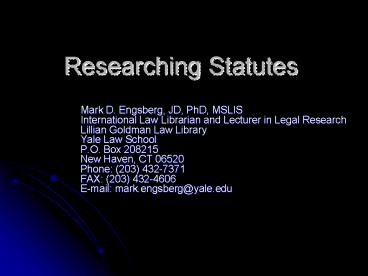Researching Statutes - PowerPoint PPT Presentation
1 / 16
Title:
Researching Statutes
Description:
You'll need between 3-5 volumes to cover an entire Congressional session. ... There is a congressional office that decides where a statute gets placed in the code. ... – PowerPoint PPT presentation
Number of Views:52
Avg rating:3.0/5.0
Title: Researching Statutes
1
Researching Statutes
- Mark D. Engsberg, JD, PhD, MSLISInternational
Law Librarian and Lecturer in Legal
ResearchLillian Goldman Law LibraryYale Law
SchoolP.O. Box 208215New Haven, CT 06520Phone
(203) 432-7371FAX (203) 432-4606E-mail
mark.engsberg_at_yale.edu
2
Federal Statutes
- Enacted one at a time
- Each one is created as an individual entity known
as a public law (abbreviated P.L.) - Published individually and numbered
chronologically - For example P.L. 100-23 can be read as the 23rd
act passed by the 100th Congress
3
A statute is
- A law enacted by a legislative body
- Federal
- State
- Or other level (e.g territorial legislature, as
in Puerto Rico)
4
- Federal Statutes are first published in pamphlet
form called a slip law.
5
They are then published in bound volumes in the
United States Statutes at Large (Stat)The
Statutes at Large are an official source of the
law.
- New volumes are published about two years behind
the enactment of laws, so as a print resource,
the US Statutes at Large are often woefully out
of date. - The US Statutes at Large is located in the main
reading room on L3 of the library.
6
To find a particular statute
- It helps to know the year or Congress number in
which it was enacted. - Go to the US Statutes at Large volume (s)
covering that year/Congress. - The laws enacted in that year are published in
full text in numerical order.
7
Individual statutes can also be found in a
similar set entitled U.S. Code, Congressional,
and Administrative News (USSCAN)
8
USSCAN also contains some legislative history of
the statutes (hearings, reports, etc.)
- USSCAN updated regularly with soft-bound
supplements - Youll need between 3-5 volumes to cover an
entire Congressional session.
9
But what if I dont know the Congress or year of
the statute? How would I find laws related to,
for example, the Uranium Pew-36 Explosive Space
modulator?
10
You have to use THE CODE
11
The United States Code
- An organized subject arrangement containing all
statutes of general application currently in
force. - Along with the US Statutes at Large, its an
official source of US law. - Contains 50 titles (because there are 50 states!)
- There is a congressional office that decides
where a statute gets placed in the code.
12
There are this many unofficial US Code
publications.They are
13
- United States Code Annotated (aka USCA)
- --A West Publication!
- United States Code Service (aka USCS)
- --A Lexis Publication!
- All three publishers organize these sets by title
numbers and section numbers. The same numbering
is used in all three sets. - e.g. 42 U.S.C. 1983 is the same text as 42
U.S.C.A. 1983 and 42 U.S.C.S. 1983.
14
Advantages to the USCA and USCS
- USCS and USCA are annotated codes. They contain
very helpful references to cases, encyclopedia
topics, and law review articles that construe,
explain, or otherwise discuss a particular
statute. - They are published more frequently than the USC.
- They are much better indexed.
15
Code Indices
- Use the code index to find statutes on a
particular subject. - Indices are usually in separately bound volumes
at the end of the code set. - Look under any and all relevant terms.
- The index will provide title and section numbers.
- Do not forget to check the pocket parts and/or
supplements.
16
Tables Volumes
- Use these to locate statutes by popular name
(e.g. the Brady Law). - You can also use them to trace a public law (each
section) to its location in a code. - P.L. numbers and section numbers appear in the
first two columns of a table and are matched with
title and section numbers of a code in the third
and fourth columns. - Tables volumes are also useful for finding where
an older statutory section was placed after a
code was re-organized or re-numbered.































